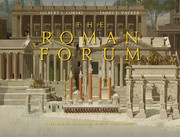Book contents
- Frontmatter
- Map
- Contents
- Preface
- Acknowledgments
- Part I. Architecture in the Roman Forum during the Empire: A Brief History
- Part II. The Monuments
- 3 The Temple of Antoninus and Faustina
- 4 The Temple of Caesar (Aedes divi Iuli)
- 5 The Basilica Æmilia
- 6 The Curia
- 7 The Arch of Septimius Severus
- 8 Minor Monuments
- 9 The Temple of Concord
- 10 The Temple of Vespasian
- 11 The Tabularium
- 12 The Portico of the Dei Consentes
- 13 The Temple of Saturn
- 14 The Basilica Julia
- 15 The Arch of Tiberius
- 16 The Schola Xanthi
- 17 The Diocletianic Honorary Columns
- 18 The Temple of Castor and Pollux
- 19 The Parthian Arch of Augustus (19 BCE)
- 20 The Temple of Vesta
- Part III. Conclusions
- Glossary
- Notes
- Bibliography
- Sources for Coin Images from the Internet and for Other Images
- Index
3 - The Temple of Antoninus and Faustina
from Part II. - The Monuments
Published online by Cambridge University Press: 05 March 2015
- Frontmatter
- Map
- Contents
- Preface
- Acknowledgments
- Part I. Architecture in the Roman Forum during the Empire: A Brief History
- Part II. The Monuments
- 3 The Temple of Antoninus and Faustina
- 4 The Temple of Caesar (Aedes divi Iuli)
- 5 The Basilica Æmilia
- 6 The Curia
- 7 The Arch of Septimius Severus
- 8 Minor Monuments
- 9 The Temple of Concord
- 10 The Temple of Vespasian
- 11 The Tabularium
- 12 The Portico of the Dei Consentes
- 13 The Temple of Saturn
- 14 The Basilica Julia
- 15 The Arch of Tiberius
- 16 The Schola Xanthi
- 17 The Diocletianic Honorary Columns
- 18 The Temple of Castor and Pollux
- 19 The Parthian Arch of Augustus (19 BCE)
- 20 The Temple of Vesta
- Part III. Conclusions
- Glossary
- Notes
- Bibliography
- Sources for Coin Images from the Internet and for Other Images
- Index
Summary
Antiquity
Antoninus Pius’ father was descended from a wealthy family in Trans-Alpine Gaul that had migrated to Rome, attaining the consulship in the days of Antoninus’ grandfather. His mother came from the upper echelons of the senatorial aristocracy in Rome. Born September 19, 86 CE, Antoninus was reared at a family estate at Lanuvium about ten miles west of Rome. His lofty family connections led to an official career that Antoninus – described in his ancient biography as a brilliant, handsome young man – carried out with notable success. His achievements attracted the attention of the emperor Hadrian, who appointed him chief judge of one of Italy’s four judicial districts (120). His later career was equally distinguished, and when the emperor became fatally ill early in 138, he adopted Antoninus as his successor. Dio Cassius reports the formal adoption in some detail:
…the emperor [Hadrian] convened at his house the most prominent and most respected of the senators; and lying there upon his couch, he spoke to them as follows: “…by the process of nature a maimed and witless child is often given to a parent, but by process of selection one of sound body and sound mind is certain to be chosen….I have found as emperor for you…the man whom I now give you, one who is noble, mild, tractable, prudent, neither young enough to do anything reckless nor old enough to neglect aught, one who has been brought up according to the laws and one who has exercised authority in accordance with our traditions, so that he is not ignorant of any matters pertaining to the imperial office, but can handle them all effectively….Although I know him to be the least inclined of men to become involved in affairs and be far from desiring such power, still I do not think he will deliberately disregard either me or you, but will accept the office even against his will.”
Coming to the throne in middle age (he was 52) after long government service, Antoninus was, as Hadrian indicated, thoroughly trained for his new position, and his twenty-three-year reign was famously peaceful and prosperous. Yet, he had had some misfortunes. His two sons and his eldest daughter were dead before he ascended the throne, and in 141 his wife, Faustina, also died prematurely.
- Type
- Chapter
- Information
- The Roman ForumA Reconstruction and Architectural Guide, pp. 66 - 81Publisher: Cambridge University PressPrint publication year: 2015

